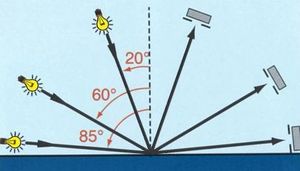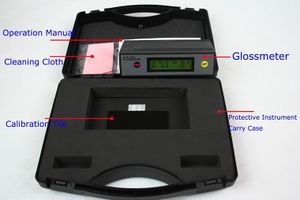Difference between revisions of "Gloss Meters"
(Created page with "Category:Measuring, Calibration{{Knoppen}} <noinclude><!------------------------------------------------ * READ THIS FIRST * Only edit this page if you can improve the cont...") |
|||
| Line 7: | Line 7: | ||
* Please start editing this page after the /noinclude | * Please start editing this page after the /noinclude | ||
* -------------------------------------------------></noinclude> | * -------------------------------------------------></noinclude> | ||
This | [[File:Angles Used by the Gloss Meter.jpg|thumb|right|Angles Used by the Gloss Meter]] | ||
[[File:Gloss meter.jpg|thumb|right|Gloss Meters]] | |||
'''Glossmeter''' is an instrument which is used to measure gloss of materials such as paint, plastics and paper. Gloss is a measure of the proportion of light that has a specular reflection from the surface. A surface such as a mirror has a high gloss, where a surface such as chalk has less because the light reflected is diffused. Numerous international technical standards define the method of use and specifications of different types of glossmeter used on different types of materials. Some of these materials include ceramics, paper, metals, and plastics. A major user of gloss meters is the auto industry. The uses for automobiles extend from the factory floor to the repair shop. | |||
==Measurement== | |||
The glossmeter provides a quantifiable way of measuring gloss intensity ensuring consistency of measurement by defining the precise illumination and viewing conditions. The configuration of both illumination source and observation reception angles allows measurement over a small range of the overall reflection angle. The measurement results of a glossmeter are related to the amount of reflected light from a black glass standard with a defined refractive index. The ratio of reflected to incident light for the specimen, compared to the ratio for the gloss standard, is recorded as gloss units. | |||
==Gloss units== | |||
The measurement scale, Gloss Units (GU), of a glossmeter is a scaling based on a highly polished reference black glass standard with a defined refractive index having a specular reflectance of 100GU at the specified angle.This standard is used to establish an upper point calibration of 100 with the lower end point established at 0 on a perfectly matt surface. This scaling is suitable for most non-metallic coatings and materials (paints and plastics) as they generally fall within this range. For other materials, highly reflective in appearance (mirrors, plated / raw metal components), higher values can be achieved reaching 2000 Gloss Units. For transparent materials, these values can also be increased due to multiple reflections within the material. For these applications it is common to use % reflection of incident light rather than Gloss Units. | |||
==Sources== | |||
http://en.wikipedia.org/wiki/Glossmeter | |||
Latest revision as of 03:52, 4 January 2013
Glossmeter is an instrument which is used to measure gloss of materials such as paint, plastics and paper. Gloss is a measure of the proportion of light that has a specular reflection from the surface. A surface such as a mirror has a high gloss, where a surface such as chalk has less because the light reflected is diffused. Numerous international technical standards define the method of use and specifications of different types of glossmeter used on different types of materials. Some of these materials include ceramics, paper, metals, and plastics. A major user of gloss meters is the auto industry. The uses for automobiles extend from the factory floor to the repair shop.
Measurement
The glossmeter provides a quantifiable way of measuring gloss intensity ensuring consistency of measurement by defining the precise illumination and viewing conditions. The configuration of both illumination source and observation reception angles allows measurement over a small range of the overall reflection angle. The measurement results of a glossmeter are related to the amount of reflected light from a black glass standard with a defined refractive index. The ratio of reflected to incident light for the specimen, compared to the ratio for the gloss standard, is recorded as gloss units.
Gloss units
The measurement scale, Gloss Units (GU), of a glossmeter is a scaling based on a highly polished reference black glass standard with a defined refractive index having a specular reflectance of 100GU at the specified angle.This standard is used to establish an upper point calibration of 100 with the lower end point established at 0 on a perfectly matt surface. This scaling is suitable for most non-metallic coatings and materials (paints and plastics) as they generally fall within this range. For other materials, highly reflective in appearance (mirrors, plated / raw metal components), higher values can be achieved reaching 2000 Gloss Units. For transparent materials, these values can also be increased due to multiple reflections within the material. For these applications it is common to use % reflection of incident light rather than Gloss Units.

